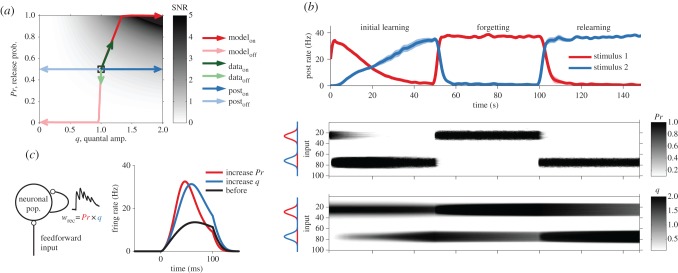Figure 2.
Compared with postsynaptic expression alone, STDP with pre- and postsynaptic expression improves sensory perception, enables memory savings and shortens response latencies. (a) Changes in the signal-to-noise ratio (SNR) during receptive field learning in the STDP model. The SNR is represented by the grey scale; the curves represent the various plasticity trajectories starting from the initial condition in the centre. Poisson train inputs that were stimulated at a high rate (‘on’) obtain high SNR for postsynaptic-only potentiation (dark blue arrows), but combining pre- and postsynaptic potentiation yields considerably better SNR (dark red arrows). Weakly stimulated inputs (‘off’) obtain lower SNR in either condition (light blue and light red arrows). These modelling results are in keeping with the observed modifications of in vivo synaptic responses to a tone from on and off receptive field positions (dark and light green arrows) [97]. (b) Rapid relearning and memory savings with asymmetrically combined pre- and postsynaptic expression of long-term plasticity. Top: response of a neuron to two stimuli, red and blue. The neuron is initially trained on the blue stimulus, and becomes over time selective to it. This initial learning is slow because the changes in q (bottom panel) are slow. After learning, the memory is overwritten with the red stimulus. However, when switching back to the initial blue stimulus, the relearning is more rapid than at first exposure. Middle: presynaptic LTP and LTD can rapidly completely reverse each other. Bottom: LTP has a postsynaptic component that does not reverse quickly, which means a postsynaptic trace is left behind after overwriting with novel information. This hidden trace enables rapid relearning of previously learnt, but overwritten, information. (c) Left: schematic of a firing-rate model with feed-forward and feedback connections as described in [22]. In this network, recurrent synapses are short-term depressing. Changing release probability Pr affects the short-term dynamics, while changing the postsynaptic amplitude q only scales the postsynaptic response. Right: comparison of changes in the response to a 100 ms step stimulus in the recurrent network model when the recurrent synapses are subject to changes in either Pr or q. Increases in the release probability shorten the latency more than increases in the postsynaptic amplitude. Panels (a) and (b) were reproduced with permission from [16].

